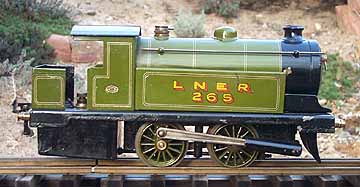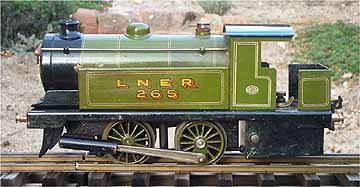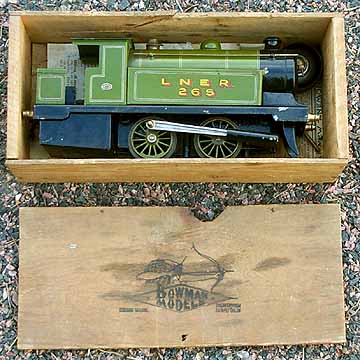
Back to Sidestreet Bannerworks
November 2000
Bowman 0-4-0T
by Marc Horovitz

Bowman Models, begun in 1923 by Mr. Geoffrey Bowman Jenkins, produced a variety of steam toys and models in the mid 1920s and 1930s. These included stationary engines for driving Meccano models, boats of different varieties, and locomotives.
The company produced a 4-4-0 with tender and two sizes of 0-4-0 tank engine, the larger of which is discussed here. All of these engines ran on 0-gauge track, but were over-scale for 0 gauge, being proportioned more like gauge-1 models. Bowman offered a line of oversize coaches and goods wagons to suit the engines.
Bowman's locomotives were both cheap and robust and they ran well in the garden. Allen Levy, in his book A Century of Model Trains, says that Bowman's products ". . .can best be described as honest, durable, efficient and incredibly ugly." The company went out of business in 1935.
The engine
While it is incredibly ugly, Bowman's LNER 265 is well built. It is basic in the extreme, possessing neither throttle nor reversing gear of any kind. Its speed was controlled by adjusting the wicks or by hanging a longer train off the back end. Its cast-iron drivers were not connected by side rods, technically making this a 2-2-0, not an 0-4-0. The single-acting oscillating cylinders powered only the rear set of wheels.
The engine is equipped with large, brass pistons. Cylinder lubrication, very important in locomotives of this type, was accomplished by the ingenious method of building felt pads into the drive rod, immediately behind the pistons. These were kept soaked with oil (only Bowman Loco Oil was to be used) and so constantly kept the cylinders lubricated and obviating the need for a secondary lubricator.
Alcohol was the fuel of choice in the days when this engine was built. The loco is equipped with a massive tank under the footplate. This is filled by removing a cap in the cab. The entire burner can be easily dropped for wick adjustment. The burner itself has six (!) 1/4" wick tubes. The boiler is shielded by the side tanks, providing extra effective surface area.
No. 265 is finished in olive green and black, with lining and lettering lithographed on, unusual for a live-steam loco, but in keeping with the company's line of rolling stock.
Sadly, my engine is not in running condition, the safety-valve spring having given up the ghost. Perhaps one day I'll replace it and take this relic from a bygone era out for a run.
Bibliography
Toyshop Steam by Basil Harley, Argus Books, 1978
A Century of Model Trains by Allen Levy, New Cavendish Books, 1974
Toy Trains: A History, by Pierce Carlson, Harper & Row, 1986
| Specifications | |
| Builder | Bowman Models, Dereham, Norfolk, England |
| Date built | circa 1927 |
| Gauge | 32mm (0 gauge) |
| Scale | No specific scale -- about the size of gauge-1 locos |
| Boiler | Pot boiler |
| Fittings | Safety valve |
| Fuel | Alcohol |
| Working pressure | 15 psi (estimated) |
| Cylinders | Two, single-acting oscillators, 180 degrees apart |
| Reversing gear | None |
| Dimensions | Length over end beams, 10-1/2"; width, 2-3/4"; height, 4-3/4" |






Below: The instructions. This set is somewhat rat-eaten. Bowman was cavalier about repairs, having no qualms in palming them off on others. From the instructions. . . "Slight repairs can be most cheaply executed by a local model engineer or cycle dealer. It is also advisable to consult him, showing these instructions, if for no apparent reason the engine is not quite satisfactory. Some simple point may have been misunderstood which he can explain and so save double postage."


Loco of the Month homepage
Back to
Sidestreet Bannerworks